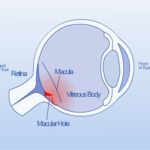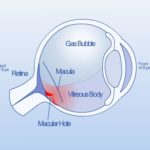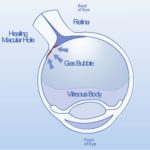Why is Face Down Recovery essential to the healing process?

The macula is the small part of the retina responsible for central vision. A tear or hole in the macula impairs a person’s ability to see. Many activities, including reading and writing, may become nearly impossible.
This condition, most prevalent among the elderly, arises when the vitreous (the jelly-like substance which fills the inner eye) becomes condensed and fibrous. The fibers often bond to the macula, and when they shrink, they exert a pulling force. A hole is opened (see Figure 1), and the surrounding tissue peels away from the eye, causing a loss of central vision.

To repair the macular hole, the surgeon removes the vitreous and replaces it with a gas bubble (see Figure 2). The bubble is meant to rise and apply pressure to the area in need of healing. Since the macula is at the back of the eye, the gas bubble will only aid healing if the patient remains with their face down.
Pressure against the hole flattens the macula against the wall of the eye (see Figure 3), and the impaired visual area is helped to heal. During the ensuing weeks, the afflicted eye will begin to heal, the macula will re-bond to the eye wall, and as the gas bubble is absorbed by the eye it will be replaced by the clear vitreous fluid which your eye produces at all times.

Macular hole surgery is an easy, painless procedure with a successful track record of improving or virtually restoring vision. The real challenge for you while you’re recovering is dealing with the monotony, stress and discomfort of a 22-24 hour-a-day facedown postoperative position until the gas bubble is absorbed-usually over a 2 to 6 week period.
OWL Leasing can help. Using our ergonomic Vitrectomy Support Systems you are able to comply with the strict positioning required, while comfortably pursuing many normal activities and getting the rest you need at night.